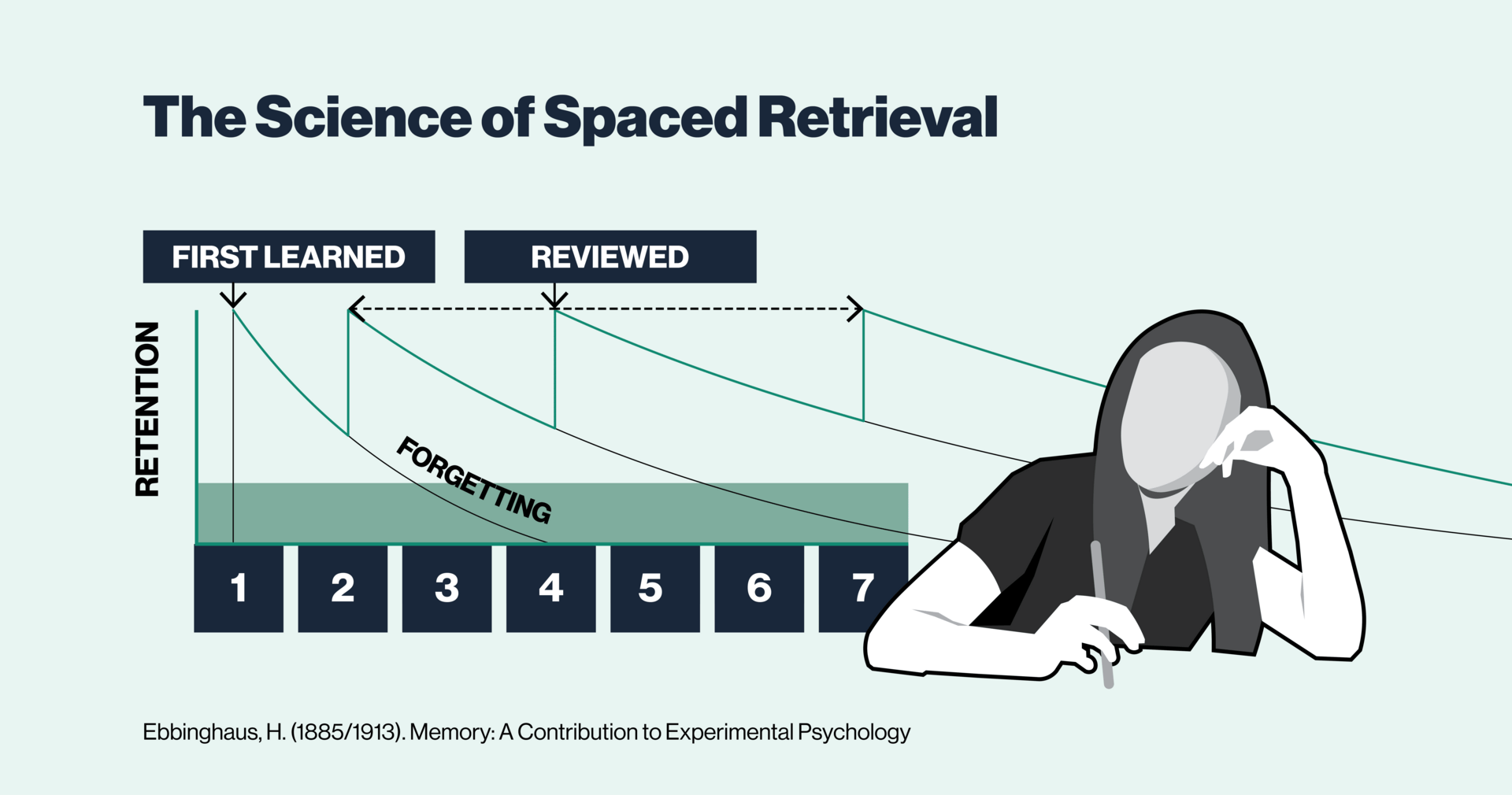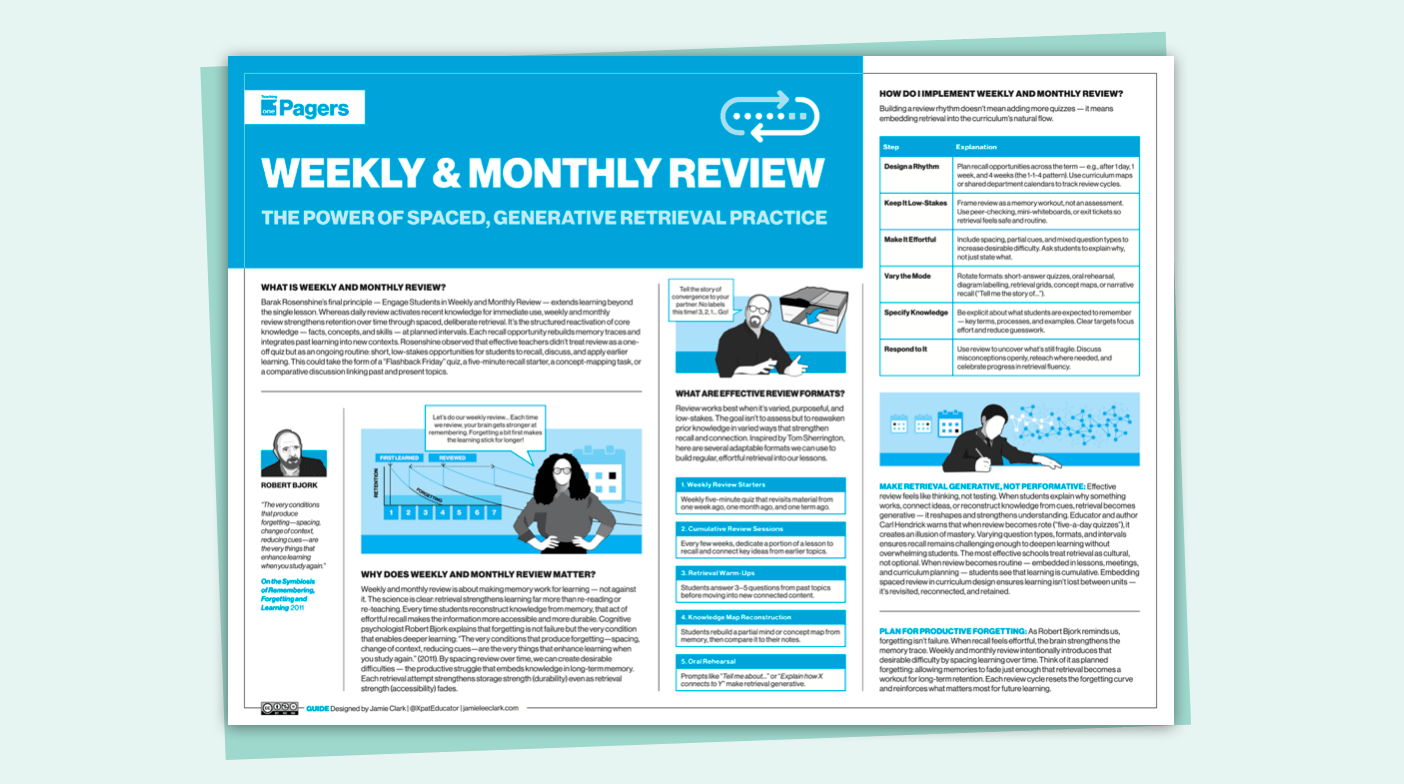👋 Hey {{first name | friend!}}
In this edition of ⚗️DistillED, we’re exploring Rosenshine’s 10th Principle of Instruction: Engage Students in Weekly & Monthly Review.

What is Weekly & Monthly Review?
Rosenshine’s final principle — Engage Students in Weekly and Monthly Review — extends the process of learning beyond the single lesson. While daily review activates prior knowledge at the start of a new lesson, weekly and monthly review aims to strengthen long-term retention by deliberately revisiting, retrieving, and reconnecting knowledge over time… Unless we revisit knowledge, we will forget it!
In essence, it’s a structured system for spaced retrieval: the repeated, effortful recall of key ideas at increasing intervals to prevent forgetting and reinforce schema. In his paper, Rosenshine wrote:
“Students need to be involved in extensive practice in order to develop well-connected and automatic knowledge.”
His research drew heavily on classroom observations of effective teachers, who consistently revisited prior learning through low-stakes questioning, discussion, and cumulative practice.
Weekly and monthly review doesn’t need to be elaborate. It’s the deliberate design of opportunities for students to bring old learning back to mind, often disguised as part of normal lesson flow. Learning shouldn’t disappear once a topic ends. Teachers who revisit old material systematically, foster greater retention, fluency, and transfer.
Before we go any further, let’s unpack the differences between Daily Review and Weekly and Monthly Review:
Aspect | Daily Review | Weekly, Monthly Review |
|---|---|---|
Why? | Activates knowledge for today’s lesson | Reinforces knowledge to prevent forgetting |
When? | At the start of a lesson (short-term recall) | Scheduled weekly or monthly (long-term recall) |
How? | Quick warm-up or recap to prepare students for new learning | Spaced, cumulative retrieval to strengthen memory and over time |
Why does Weekly & Monthly Review Matter?
This principle is all about memory. The science of learning shows that retrieval strengthens learning far more than re-exposure. Each time students reconstruct knowledge from memory—rather than re-read or re-watch—it becomes more accessible, more connected, and more durable.
But here’s the paradox: Learning depends on forgetting! As Dr Robert Bjork explains in The Power of Forgetting (UCLA), there are two kinds of memory strength:
Retrieval strength — how easily something can be recalled right now.
Storage strength — how deeply it’s embedded and connected in long-term memory.
Over time, retrieval strength fades, but storage strength remains. Something can feel “forgotten” and still be fully stored in memory, waiting to be reactivated. Bjork describes this as a symbiosis between remembering, forgetting, and learning:
“The very conditions that produce forgetting—spacing, change of context, reducing cues—are the very things that enhance learning when you study again.”
This is what Rosenshine’s weekly and monthly review is designed to harness. By spacing practice over time and revisiting knowledge in new contexts, teachers deliberately create the conditions that make retrieval effortful—and therefore powerful. The diagram below illustrates the Ebbinghaus Forgetting Curve — how memory decays over time without review.

Each act of retrieval interrupts forgetting. Weekly and monthly review “resets” the curve
Ultimately, weekly and monthly review helps maximise learning because it:
Strengthens Memory: Effortful retrieval at spaced intervals consolidates knowledge and makes it easier to recall later (Bjork & Bjork, 1994).
Combats Forgetting: Revisiting content after delay interrupts the forgetting curve and reinforces long-term retention (Ebbinghaus, 1885; Rosenshine, 2012).
Deepens Understanding: Recalling past learning in new contexts builds schema and connects ideas across topics.
Frees Cognitive Load: When essential knowledge is retrieved automatically, working memory is released for deeper thinking (Sweller, 1988).
Builds a Learning Culture: Routinised retrieval signals that learning is cumulative, not disposable—every review strengthens the foundation for what comes next.
Educator Carl Hendrick warns that easy or routine retrieval can create a false sense of mastery. Effective review should be spaced, effortful, and varied, prompting students to think harder and connect ideas across contexts.
So, how do we ensure review leads to real learning—not just the illusion of it?
Let’s explore some formats and approaches…
How do I Implement Weekly & Monthly Review?
Turning this principle into practice is less about adding new activities and more about embedding a culture of recall.
Weekly & Monthly Review Formats
Vary review formats to sustain challenge and interest. See Tom Sherrington’s Rosenshine Masterclass: Daily, Weekly and Monthly Review for practical ways to keep retrieval purposeful and generative.
Weekly Review Starters: Every Monday, a five-minute “Flashback Quiz” that revisits material from one week ago, one month ago, and one term ago.
Cumulative Review Sessions: Every few weeks, teachers dedicate a portion of a lesson to recall and connect key ideas from earlier topics — for example, comparing poetic techniques studied across two different units.
Retrieval Warm-Ups: Students answer 3–5 questions from past topics before moving into new content, often via mini whiteboards or paired discussion.
Knowledge Map Reconstruction: Students rebuild a mind map or concept web from memory, then compare it to their notes to identify gaps.
Oral rehearsal: Using prompts like “Tell me the story of…” or “Explain how X connects to Y” to make retrieval generative and narrative rather than mechanical.
In true ⚗️DistillED fashion, here’s a six-step approach to designing weekly and monthly review with precision — balancing challenge, recall, and long-term retention every step of the way.
Step | Explanation | Example |
|---|---|---|
1. Design a Review Rhythm
| Build recall into curriculum maps using spaced intervals (1 day → 1 week → 4 weeks) to strengthen retention. | “Let’s start with two questions from last month’s topic.” |
2. Keep it Low-Stakes
| Frame retrieval as a memory workout, not a test. Use self-checks, peer marking, or quick cues to lower pressure. | “We’re training our brains to remember for longer, not testing what you know today.” |
3. Make it Effortful
| Increase challenge through spacing, mixed question types, and prompts that require explanation, not recall alone. | “Explain why this example fits the rule—not just what the rule is.” |
4. Vary the Mode
| Rotate between oral rehearsal, retrieval grids, mind maps, and diagram labelling to keep practice generative. | “Sketch the process from memory, then compare with your notes.” |
5. Specify the Knowledge
| Identify key terms, ideas, or processes students must remember to reduce guesswork and direct effort. | “List the three causes of the event and define each one.” |
6. Diagnose & Re-teach
| Treat mistakes as feedback for instruction, not failure—reteach what isn’t yet secure. | “Which question tripped most of us up? Let’s revisit that concept together.” |
Until next week — keep review spaced, retrieval effortful, and learning long-lasting.
Jamie
Free Resource Download
Weekly & Monthly Review One-Page Guide Free Download
This NEW one-page guide breaks down Rosenshine’s 10th Principle — Engage Students in Weekly & Monthly Review — into a clear, practical format. It walks you through the what, why, and how of spaced retrieval, explains the science behind the forgetting curve, and offers ready-to-use strategies to strengthen long-term memory.

The Review Rhythm Planner Free Download
A one-page printable example for English teachers showing how to map review opportunities across a term. Use it to plan 1-day, 1-week, and 4-week retrieval cycles — ensuring key knowledge, texts, and writing skills are revisited and retained.

DistillED+ Checklist and Slideshow
This week’s ⚗️DistillED+ resources include a Review Rhythm Planner and a CPD Slideshow. Together, they unpack the what, why, and how of Rosenshine’s 10th Principle — helping you design retrieval routines that make forgetting work for you. Explore how to plan 1-day, 1-week, and 4-week reviews, vary retrieval formats, and embed spaced practice across your curriculum to make learning last.
If you’re a ⚗️DistillED+ member, scroll to the bottom of this post to access the exclusive download. You can also visit the DistillED+ Hub to explore the full library of member-only resources.

Upgrade to DistillED+ to get this content!
Join DistillED+
Members gain access to expertly curated digital evidence-informed content
UPGRADEA ⚗️DistillED+ subscription gets you:
- Full access to new premium one-page guides
- Full access to evidence-informed strategy checklists
- Full access to slide templates (PowerPoint and Keynote)


